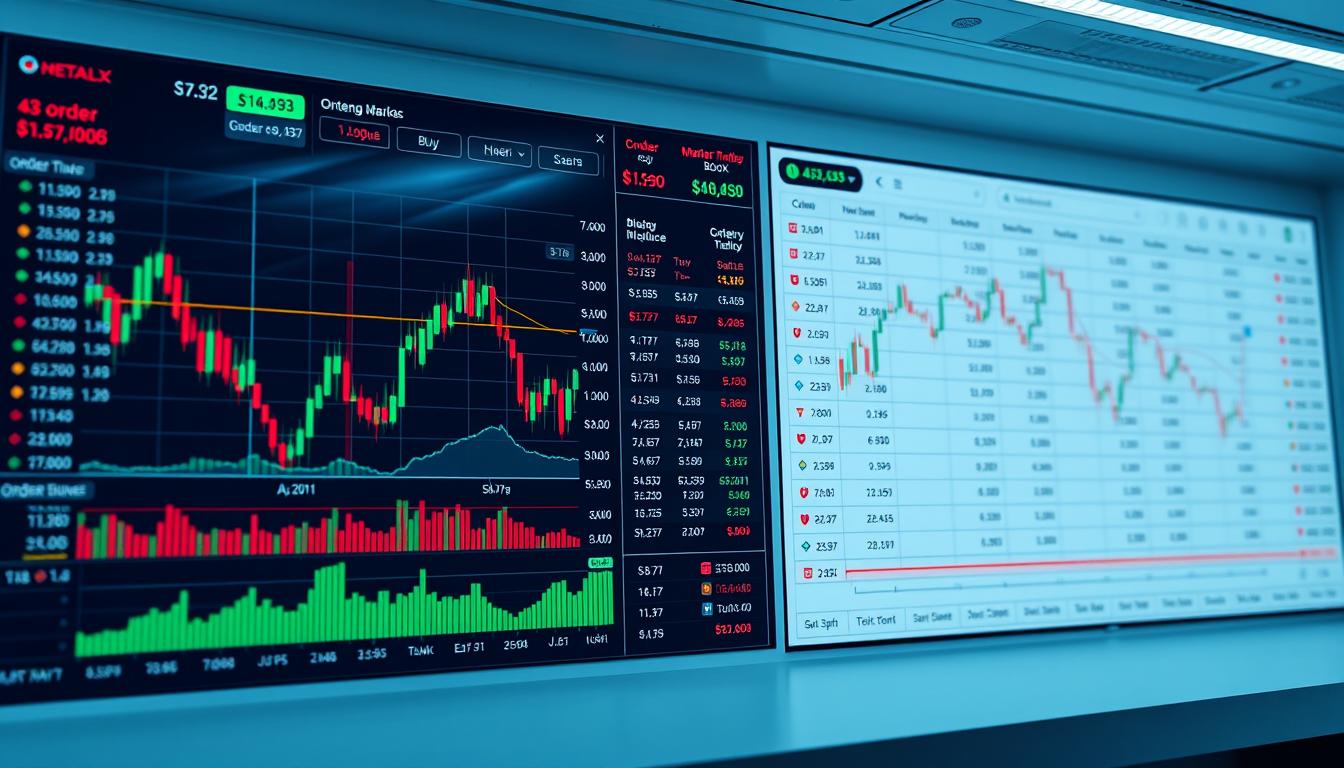The crypto market never stops, with prices changing fast. Traders use order books to keep up. An order book is a list of all buy and sell orders for a certain crypto pair.
An order book shows real-time data. It updates as traders place new orders or cancel old ones. Knowing how to read an order book helps make smart trading choices.
By learning about order book analysis, you can get ahead in the market. It shows things that price charts can’t.
Key Takeaways
- Understand the structure of an order book, including bids and asks.
- Learn how to interpret order books for informed trading decisions.
- Discover the importance of order books in the volatile crypto market.
- Gain insights into market sentiment through order book analysis.
- Improve your trading outcomes by mastering order book interpretation.
Understanding Order Books in Cryptocurrency Markets
To do well in the crypto market, knowing about order books is key. An order book shows all current buy and sell orders for a crypto pair. It helps see what the market is thinking.
What Is a Crypto Order Book?
A crypto order book is a list of buy orders and sell orders for a crypto. It shows the market’s demand and supply. This helps traders make better choices.
Key Components: Bids, Asks, and Spreads
The order book has two parts: the bid side and the ask side. The bid side lists buy orders from highest to lowest price. The ask side lists sell orders from lowest to highest price. The spread is the difference between the highest bid and the lowest ask. It shows the market’s liquidity and how volatile it is.
| Component | Description |
|---|---|
| Bid Side | Lists buy orders from highest to lowest price |
| Ask Side | Lists sell orders from lowest to highest price |
| Spread | Difference between the highest bid and lowest ask |
How to Use Order Books in Crypto Trading

To use order books well in crypto trading, you need to know how to read them. This means looking at the current market price, understanding the market depth, and finding support and resistance levels.
Reading and Interpreting Order Book Data
Reading order book data is important. First, find the current market price where buy and sell orders meet. Then, look at volume to see how much is being traded at each price. Here are some key things to notice:
- Find the current market price and see how it fits with the surrounding orders.
- Check the market depth by looking at the total amount of orders at each price.
- Look for patterns in the order book data that might show future price changes or shifts in market sentiment.
Order Book Visualization Tools
Order book visualization tools, like depth charts, make complex data easy to see. They show the number of buy and sell orders at each price. This helps spot big buy or sell walls.
These tools help you understand market trends. They make trading decisions easier.
Most Read:-Scalping in Crypto: A Beginner’s Guide
Market Dynamics Revealed Through Order Books

Order books let you see market dynamics clearly. They show what drives price changes in crypto markets.
Supply and Demand Indicators
The order book shows supply and demand in real-time. It lists all buy and sell orders at different prices. This gives a snapshot of market feelings.
When buy and sell orders are not balanced, big price changes can happen. A lot of buy orders at one price can push the price up.
Identifying Market Liquidity
Market liquidity is key for traders. It shows how easy it is to buy or sell without changing the price. Many orders at different prices mean high liquidity.
But, few orders mean low liquidity. This can cause big price slippage. Here’s how to spot liquidity in the order book.
| Liquidity Level | Order Book Characteristics | Price Impact |
|---|---|---|
| High | Many orders at various price levels | Minimal price slippage |
| Low | Fewer orders | Significant price slippage |
Order Book Trading Strategies for Crypto

Learning order book trading strategies can boost your crypto trading. Understanding order book data helps make better trading choices.
Spotting Support and Resistance Levels
Identifying support and resistance levels is a key strategy. Support levels are where buy orders are many, showing a price might go up. Resistance levels are where sell orders are many, showing a price might go down.
Knowing these levels helps time your trades better.
Using Order Imbalances to Predict Price Movements
Another strategy is watching order imbalances. Order book imbalances show if prices might move. More buy orders than sell orders can mean prices might go up.
This info helps predict and react to market changes.
| Strategy | Description | Market Indicator |
|---|---|---|
| Support/Resistance | Identify clusters of buy/sell orders | Potential price reversal |
| Order Imbalance | Monitor buy/sell order volume differences | Potential price movement direction |
Advanced Order Book Analysis Techniques

To improve your crypto trading, learn advanced order book analysis. This means understanding the depth and dynamics of the order book for better trading decisions.
Recognizing Buy and Sell Walls
Big groups of buy orders on the bid side can be support zones. Big groups of sell orders on the ask side can be resistance. Spotting these buy and sell walls helps understand market feelings and make better trade choices.
Detecting Market Manipulation Patterns
Order book analysis can spot market manipulation like spoofing and layering. Watch the order book depth for oddities. This helps predict price changes and adjust your plans.
| Pattern | Description | Impact |
|---|---|---|
| Spoofing | Placing fake orders to manipulate market sentiment | Artificial price movement |
| Layering | Placing multiple orders at different price levels to create a false impression | Distorted market perception |
Common Order Book Pitfalls and How to Avoid Them
Understanding common pitfalls in order book analysis is key to success in crypto trading. The order book is powerful but tricky to use. Knowing how to avoid traps is crucial.
Misinterpreting Order Book Signals
Misreading order book signals can lead to bad trading choices. Be careful of short-term patterns that look like big trends. Always check order book data with other tools and methods.
Managing Slippage in Low Liquidity Markets
In low liquidity markets, slippage can greatly affect trading results. To handle slippage, watch market conditions and adjust your plans. Use limit orders and stay updated on market trends to reduce losses.
Knowing these common pitfalls and how to dodge them can improve your trading. It helps make better choices.
FAQ
What is the significance of the highest bid and lowest ask in an order book?
The highest bid and lowest ask are crucial in determining the market price of a cryptocurrency. The highest bid represents the maximum price a buyer is willing to pay, while the lowest ask is the minimum price a seller is willing to accept.
How do I identify market liquidity using an order book?
You can gauge market liquidity by examining the depth of buy and sell orders at various price levels. A liquid market typically has a large number of orders at or near the current market price, indicating a high level of trading activity.
What is the difference between a buy wall and a sell wall in an order book?
A buy wall is a large accumulation of buy orders at a specific price level, indicating strong demand. Conversely, a sell wall is a large accumulation of sell orders, representing a significant supply of the asset.
How can I use order book data to predict price movements?
By analyzing order book imbalances, such as a surplus of buy or sell orders, you can gain insights into potential price movements. A significant imbalance can indicate a shift in market sentiment.
What is slippage, and how can I manage it in low liquidity markets?
Slippage occurs when a trade is executed at a different price than expected, often due to low liquidity. To manage slippage, you can use limit orders, which allow you to specify the maximum price you’re willing to pay or the minimum price you’re willing to accept.
Can order books be used to detect market manipulation?
Yes, order books can be used to identify potential market manipulation patterns, such as spoofing or layering. By analyzing the order book data, you can detect unusual patterns or anomalies that may indicate manipulative activity.
How do I interpret the bid-ask spread in an order book?
The bid-ask spread represents the difference between the highest bid and the lowest ask. A narrow spread typically indicates a liquid market with low trading costs, while a wide spread can signify a less liquid market with higher trading costs.


